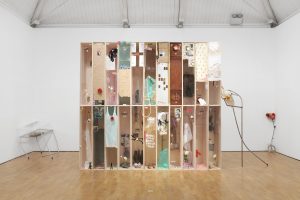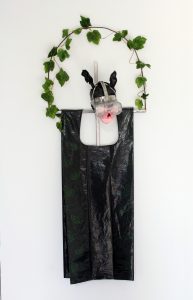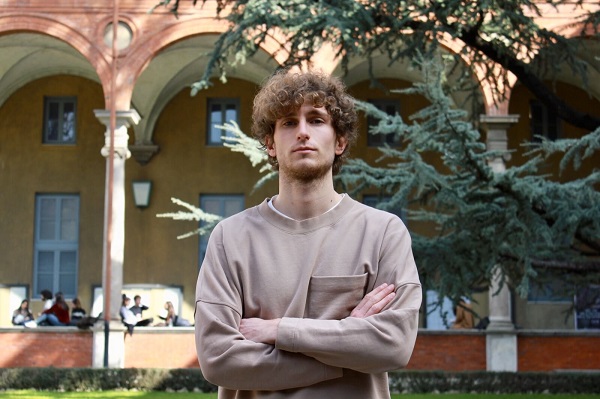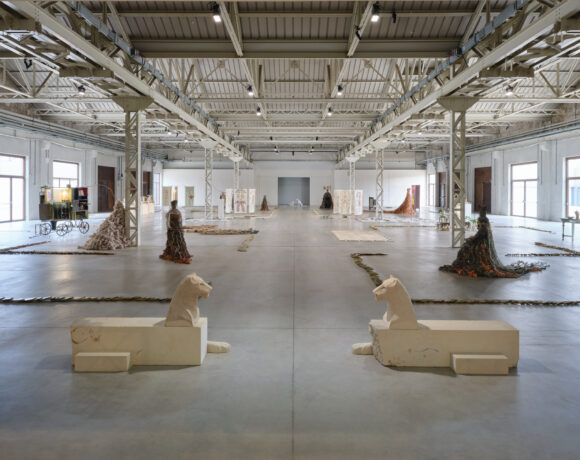“No Medals No Ribbons” is the retrospective currently on view in the spaces of the Modern Art Oxford of the British artist Jesse Darling (1981), aimed at presenting – through a large and strong exhibition structure – the results of research and work related to the last 10 years.
For the occasion, I had the opportunity to explore the broad issues addressed by the exhibition directly with Amy Budd, senior curator at the museum. As she explained immediately, the choice to dedicate such a space to Darling is essentially to be found in the desire to recognize the importance and innovative character of a practice that finds in the sculptural medium (but not only) a fundamental language for a fully articulated investigation around currently pressing issues.
Despite the celebratory intentions for an extremely structured, solid, intimate but at the same time universal work – usually implicit in the concept of a retrospective – “No Medals No Ribbons” (starting from the title) wants to make clear the artist’s need to deviate as much as possible from such an approach. The title has references to the story of a distant relative, who engaged in the Second World War in the creation of prostheses for his comrades from waste materials. At the end of the conflict, however, instead of accepting the recognition due to the commitment and heroism of his gestures, he preferred to refuse any celebratory act as, implicitly, he would have done nothing but recall the tragedies that have just passed. A starting point that already in part, defines the thematic and conceptual lines of a retrospective where is condensed a stratification of meanings. Its cornerstones can be identified in the concepts of vulnerability and transience of any system of power, dissected by a perspective where autobiographical matter and a character of universality are inseparably combined. All this also going to place a completely marked accent on the multiplicity of materials and mediums used.
Progress and anti-modernity. Monumentality and decadence. Memento mori and vulnerability. These are probably the thematic lines that most of all emerge from the first room, where the gaze can only get lost along the twisted and unstable lines of “Gravity Road” (2020). From a literal point of view, the imposing steel installation refers firstly to the story behind the birth of the modern roller coaster, which began in 1827 as a tool for transporting coal and from 1850 also developed a functionality linked to the fun of working classes. From a broader point of view, however, this sinuous intertwining – in Darling’s eyes almost a mammoth fossil – is erected as a real monument attesting to that sense of inevitable fall behind all the systems, mythologies and certainties with an almost dogmatic flavour created from modernity. The tangle is distorted and dysfunctional. It leads to nothing but a submissive contemplation and awareness that behind that idea of industrialization, progress and speed there is nothing but stories of social and economic exploitation that have always done (and will they do?) as a counterpoint to the idea of ”advancement”. At the foot of the imposing structure are placed heavy sandbags – bearing the words “Deutsches Bundesbank” – unlikely ground from which daisies and chrysanthemums seem to grow, in a way with ironic and surreal features. As Darling themselves stated: “[…] So I took a day off, I walked an hour and a half along the river to the city limit to the big box garden center and bought some flowers for the sandbags placed around the “legs” of installation […] You could still see the animals, but it felt less cartoonish, much more like a relic. Like how in natural history museums they don’t blare the lights because it decays the old things. It felt sort of somber”[1] As you can imagine, it is therefore through the instinctive, random gesture (both the bags and the flowers have no defined metaphorical meanings) that the artist seeks that sense of completion of work with a well-defined symbolic significance, whose plasticity and hardness seem apparently to be softened by the use of a natural element with aesthetic connotations substantially the opposite of the main body and able of dampening the apathetic coldness of the steel colossus with a new vital charge. Therefore, an almost dystopian scenario takes shape, strongly accentuated by the phantasmic but all-encompassing presence of “Planes” (2019), consisting of a multitude of aluminium airplanes scattered on the floor. In this case, the artist intends to trigger a reflection around the concepts of travel, migration and its environmental impact, once again subverting the logic of functionality through the use of a material (aluminium) that cancels out the playful meaning of the object to bring out, instead, necessary references on how to face today the concept of displacement with the increasingly limited availability of natural resources. Overall, the work seems to present itself as a successful blend of a conceptual and participatory approach with echoes of Felix Gonzalez Torres and the Rirkrit Tiravanija’s participative research. Moreover, the work also offers significant food for thought around the idea of resilience as airplanes cannot fly as predetermined or as one would like but instead require a different approach. Then, the critical intent tends to be reconciled with an attitude with more ironic connotations, as highlighted by “Embarrassed Billboard 1 & Embarrassed Billboard 2” (2016/2022), panels that, “tired and embarrassed”, show only their backs in clear disintegration of the advertising message stripped of its function as a consumerist stimulus.
You have more and more the impression that the path is centred around the use of “rectified” readymades that are not created through the simple everyday objects decontextualization but with their continuous re-elaboration and conferment of new connections and meanings. In particular, inside the adjacent room, Darling accentuates this aspect as an expedient for the investigation into the modern body’s dependence on myths such as medicines or cosmetics. Then, starting with the autobiographical experience it is reached a theme with universal connotations. And it is precisely this ability to generate the universal from the particular that is a further key to interpreting their practice. The profound intimacy of works such as “Composition of objects that keep things [a] live plus constellation Orion in spilled lentils on a dead refrigerator (towards non-macho sculpture practice)” (2017) or “Prophylactics Charms & Placebos “(2017) that refer to drugs actually used by the artist is simply striking. Above all, it stands out “Crawling Cane 1 & 2” (2017/2022), comprised of sculptures obtained from support distorted crutches that are loaded with both a sense of fragility and resistance (as a reference to a period of difficulty experienced by the artist) and broadly as real icons able to reaffirm health care services essentiality. But here this idea of body “dependence” is also faced from a more political and carnal perspective as evidenced by “Liberty Torch 1 (Ace of Wands Series)” (2016/2022), where hands protruding from the walls hold, reigning and proud, the Hitachi Magic Wand, the best-selling sex toy in history. The element of corporeality is also brilliantly investigated through the use of plastic in the work “The Deputation” (2017/2022), consisting of envelopes spread out and fixed on thin supports. The basic concept is precisely that of dwelling on how much this type of material, together with silicone and steel, has contributed to the definition of the single individual and community identity as simulacra of the most current narratives of capitalism, colonialism and exploitation. Finally, this purely earthly dimension of body and mortality is also presented in a sacred meaning as evidenced by the nearby room used as a votive chapel – guarded by two sphinxes symbols of the overwhelming imperial power – where emerge works referring to a strongly spiritual aura.
Generally speaking, it seems that the first two exhibition spaces allow emerging concepts such as transience and corporeality. The last room instead (a “crowded room” according to Amy Budd) hosts a nucleus of works able of making similar areas of research coexist simultaneously in the same space. We find, in fact, both steel and metal structures made with crutches and support objects referring to humanoid and animalistic forms with which it is strongly reaffirmed how the character of mortality and vulnerability represents the lowest common denominator of any entity constituting reality. An aesthetic of this type is also used for the proposition of works aimed at moving a critique of the modern Western exhibition concept, with vitrines supported by precarious and distorted structures in a broader reference to the inadequacy of similar approaches. At the same time, the body is also investigated from a gender perspective as well as the desire to overturn the stereotypical idea of masculinity as highlighted by “Saint Batman” (2016). This sort of modern crucifixion made of a garbage bag, plastic ivy and pink foam rubber refers to the artist’s ironic and irreverent will to start from typical popular characters to deconstruct their related system of meanings. In this case, the idea of strength and machismo identified in Batman crumbles with the definition of a new figure that with its distortions, precariousness and weakness does nothing but unmask what is false and unreal behind the idealization of the strength of a superhero who does not even have superpowers. Finally, at the end of the itinerary, there is “Virgin Variations 1” (2019), an impressive series of lockers containing relics typically used in the tombs as a tribute to the dead. The work is inspired by the legend of St. Ursula burned in Cologne together with 11,000 virgins, in an attempt to reveal both a funeral homage and reconstruct (through objects that could commonly be found in a student’s locker) the inner personalities of the considered subjects. All of this contributes to defining a sort of monument dedicated to the dignity and memory of all those who succumb, helpless, to the fate of anonymity enshrined in history.
In this act of absolute unmasking, avoiding unnecessary celebrations, sterile triumphalisms or imaginative messages of hope, Jesse Darling, emphasizes the vital importance of knowing how to move forward, opening up to change as something inevitable and always keeping in mind that everything will have sooner or later an end. It is precisely this essential “nothing is too big to fail” that invites us to consider another key element – that is increasingly left to the extremes of modernity from which the creators themselves are little by little marginalized – which can only find a better definition in the artist’s own words: “Vulnerability is a given, like it or not, in everybody. It’s what makes us alive. […] To acknowledge our universal vulnerability, at the level of the mortal body, is for me a way of thinking about trying to care for each other.”
[1] Jesse Darling on Gravity Road and the construction of leisure, September 30, 2020, Artforum
Info:
Jesse Darling. No Medals No Ribbons
05/03/2022 – 01/05/2022
Modern Art Oxford
30 Pembroke Street – Oxford
 Jesse Darling, Gravity Road, installation view at Modern Art Oxford, 2022. Photo by Ben Westoby, courtesy Modern Art Oxford
Jesse Darling, Gravity Road, installation view at Modern Art Oxford, 2022. Photo by Ben Westoby, courtesy Modern Art Oxford
 Jesse Darling, No Medals No Ribbons, installation view at Modern Art Oxford, 2022. Photo by Ben Westoby, courtesy Modern Art Oxford
Jesse Darling, No Medals No Ribbons, installation view at Modern Art Oxford, 2022. Photo by Ben Westoby, courtesy Modern Art Oxford
 Jesse Darling, No Medals No Ribbons, installation view at Modern Art Oxford, 2022. Photo by Ben Westoby, courtesy Modern Art Oxford
Jesse Darling, No Medals No Ribbons, installation view at Modern Art Oxford, 2022. Photo by Ben Westoby, courtesy Modern Art Oxford
 Jesse Darling, No Medals No Ribbons, installation view at Modern Art Oxford, 2022. Photo by Ben Westoby, courtesy Modern Art Oxford
Jesse Darling, No Medals No Ribbons, installation view at Modern Art Oxford, 2022. Photo by Ben Westoby, courtesy Modern Art Oxford
 Jesse Darling, Saint, Batman, 2016. Private Collection, France, courtesy Modern Art Oxford
Jesse Darling, Saint, Batman, 2016. Private Collection, France, courtesy Modern Art Oxford
 Jesse Darling, Demonstration of an order, 2018. Courtesy of the artist and Galerie, Sultana, Paris
Jesse Darling, Demonstration of an order, 2018. Courtesy of the artist and Galerie, Sultana, Paris
 Jesse Darling, Planes, installation view at Modern Art Oxford, 2022. Photo by Ben Westoby, courtesy Modern Art Oxford
Jesse Darling, Planes, installation view at Modern Art Oxford, 2022. Photo by Ben Westoby, courtesy Modern Art Oxford

With a specialist degree in Economics and Management of Cultural Heritage, passionate about the field of Contemporary art, its economic dimension and, more generally, the dynamics characterizing the art market, Gabriele has gained experience over time in contexts such as contemporary art galleries, start-ups and Art Advisory. He currently works in the Art-Rite auction house as an assistant in the department of Modern and Contemporary art.






NO COMMENT